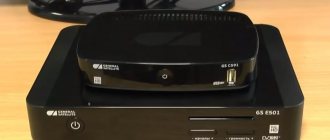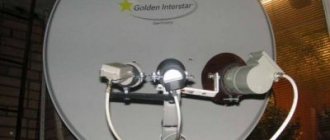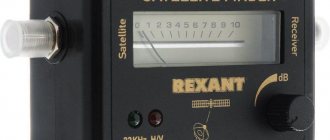What to do if Tricolor, NTV, Telekart does not show in rain or snow.
Let's first figure out why satellite TV shows poorly or doesn't show at all in rain or snow.
Rain and snow are a physical barrier to the signal from the satellite to your satellite dish.
During heavy rain or snowfall, almost everyone experiences interruptions in reception.
This is usually expressed in the picture scattering into cubes, in the image freezing, in the loss of sound.
Tricolor usually says - there is no signal and does not work.
So what can we do to improve the image in rain or snow.
The first thing you need to do is check how accurately your antenna is tuned to the satellite.
To do this, you need to have a special device for tuning satellite dishes, and it is advisable to do this when the signal disappears, during snow or rain.
Incorrect or inaccurate dish setting is the most common cause of interruptions in television broadcasts.
In good weather, the strength and power of the signal is sufficient, but when external interference appears, the signal level drops and the TV does not show anything.
The second way to improve the quality of reception is to install a dish with a larger diameter.
The larger the satellite dish area, the better the reception quality will be in rain or snow.
In some cases, when the signal was lost in the rain, a casing made of an ordinary plastic bottle, which we put on the satellite converter or head, helped.
This casing prevented water from entering the head and the signal did not disappear.
But even if you take all these measures to improve the signal quality, the satellite receiver will not show during heavy rainfalls or snowfalls.
Fortunately, this happens several times a year.
Sometimes moving the plate to the side a few meters helps.
Here are instructions on how to install and configure a satellite dish yourself.
If you want to buy a larger diameter dish or order an antenna setup in Bratsk, call 03/27/53.
Receiver failure
The most unpleasant news for those who are trying to find out why Tricolor does not work today will be the news that the receiver is malfunctioning. There are 2 types of console failures:
- software malfunction;
- damage to the equipment itself.
The first is usually associated with an incorrect or untimely interrupted update. Therefore, to avoid such difficulties, you should carry out scheduled updates, receiving the necessary programs from the satellite directly to the receiver. The second condition to avoid trouble is to not turn off the equipment while downloading and installing the program.
No matter how much you want to save money, there is only one way to restore a broken receiver - to send it in for repairs. The cost of restoration in 2021 depends on the type of breakdown and ranges from 500 to 2500 rubles.
However, if there is a valid warranty, you should not attempt repairs on your own. This will lead to the loss of the opportunity to return the device for warranty, free repairs and additional expenses.
You can find out the address of the nearest satellite company service center on the official website by going to the appropriate section of the portal.
Why does Tricolorkin not show in the rain?
When using satellite television, and especially the Tricolor system, certain misconceptions may arise. There is a rumor among people that Tricolor does not show in bad weather, and only works in clear weather, that as soon as it rains or clouds blow out, the image on the TV begins to crumble into pixels or there is no signal at all.
Let's figure out why the Tricolor doesn't show in rain or snow?
A satellite dish, also known as a dish, has a conventionally round shape. This is done in order to receive signal beams from the satellite. Modern satellite television can be received on relatively small satellite dishes. Previously, about 20 years ago, if you look at the roofs of houses at the old and rusty antennas, they were much larger. To make it possible to use small antenna mirrors, the carrier frequencies were increased. And as you know, the higher the frequency, the shorter the wavelength. In a word, by increasing the frequency, we were able to catch the satellite with small antennas. It would seem that everything is fine, but this transition also has a negative aspect. As the wavelength decreases, the external influence on the signal increases. Events such as wind, rain, snow and trees reduce the signal and have a negative impact on satellite viewing much more than in the days of big satellite dish bummers.
The wavelength in modern satellite television is only a few centimeters, and raindrops in the air, on the antenna itself and on the irradiator, can affect the quality and strength of the signal. First of all, you should check whether the position of the dish is out of order, check the quality of the convector and cable, perhaps the signal has weakened and is on the verge.
In order to reduce the effect of rain or snow on the signal from our satellite dish, we need to move to a dry region or, most simply, ensure that more signal waves reach the dish surface. So how do you do this? It's simple, you just need to install a larger diameter antenna.
Most hardware stores and chain hypermarkets sell Tricolor satellite kits with the smallest satellite antenna with a diameter of only 0.55. For reliable reception, especially in regions with frequent precipitation, such as St. Petersburg and the Leningrad Region, a dish with such a reflector area is clearly not enough.
I recommend using satellite dishes of at least 0.6 meters, and if you have several terminals connected to your dish, then it’s better to install a saucepan with a size of 0.8 meters. PS Of course, all these conclusions and advice take place in the absence of external interference in the form of trees and neighboring buildings, as well as provided that the satellite antenna is accurately aligned and tuned to the device.
Call and order, we will configure and, if necessary, replace the satellite dish
Telephone
The antenna is out of whack
If it turns out that the reason is in the antenna, then you first need to check the reliability of its fastening. To do this, you just need to take it and shake it a little. If it gets loose, you need to securely fasten it again in the correct position, and then look at the TV. If a signal appears, then you need to carry out a search procedure and create a new list of channels if it is lost.
In this case, you need to change the position of the plate very slowly, carefully, without making a step of more than 1 cm. You need to move both in the horizontal and vertical planes, but not at the same time, observing a time range of 3-5 seconds. If the TV “caught” the signal, then it is necessary to make adjustments so that the filling level of both scales (quality and signal) is greater than 70-80%. After this, tighten all the bolts so that the antenna is stable.
Why does Tricolor, NTV+, Telekarta, Raduga, Continent not show in weak or strong winds?
For some people, when there is wind, satellite TV begins to show poorly.
And it doesn’t matter which satellite operator you use: Tricolor, Raduga, NTV Plus, Continent, Telekarta, Yamal.
If, when the wind is blowing and your TV stops showing, the image crumbles into cubes, slows down, the picture on the screen freezes or the sound disappears, it means that something is interfering with the satellite signal.
The wind itself cannot, but serves as a physical barrier for the signal to reach your satellite dish.
There are three main reasons why satellite receivers do not show in the wind:
The first reason is various trees, namely their leaves and branches.
When there is no wind, the trees and foliage on them do not move, but when there is wind they begin to sway.
And if your antenna was set up in a gap or gap between the trees, then even in a weak wind they will act as a barrier to the signal.
How the strength, power and quality of the signal fluctuates in the breeze can be seen by going to the receiver settings.
My receiver has a tab for setting up or installing the antenna, it has two stripes at the bottom, they should float in the wind.
If foliage on the trees is to blame, then you need to move the antenna to another place or cut down the trees or branches that are in the way.
The second reason is poor fastening of the satellite dish to the bracket.
You can check this by going up to the antenna and trying to swing the plate in different directions with your hands; there should be no play.
If the plate starts to wobble, then you need to tighten the mounting bolts.
The third reason is poor fastening of the bracket or pipe on which the plate is attached.
The bracket must be fixed very rigidly and withstand a person’s weight of 60-80 kilograms.
If the bracket moves at the same time, then it must be secured more firmly by tightening the bolts or replacing them with larger ones.
I've seen some people attach them with nails, but that's not the way to do it.
If your plate is attached to nails, replace them with self-tapping screws.
Often dishes are installed on broadcast antenna masts or long pipes.
These masts begin to sway and sway in the wind, and the dish moves out of the zone of reliable signal reception during the turn.
In this case, the plate must be moved lower, where the amplitude is smaller.
Or make 3-4 guys on the mast to prevent it from swaying in the wind.
Weather
Thunderstorms, strong winds, heavy rain, severe frost and other adverse weather conditions can affect the quality of the received signal. If there is no signal on some channels during a thunderstorm or wind, then there is only one thing left to do - wait out the bad weather, and then check the condition of the antenna.
During the cold season, ice, sticky snow, etc. may appear on the plate. You can carefully eliminate this cause, or you can do nothing if warming is expected in the near future.
no signal on all channels, reasons and solutions
So, dear friends. This material is dedicated to those who do not have satellite TV. Satellite TV is a very common thing in the CIS countries and therefore, for some, something may happen with this method of receiving information from the outside. If you suddenly lost channels on your satellite TV and you don’t know how to get satellite TV to work, then this is the place for you.
Satellite TV is a very fragile thing in its own way, and even a properly configured receiver with an antenna can easily be damaged “in the wrong direction” by pressing or doing some non-standard actions.
Well, in this article we will help you launch your satellite TV and try to get your channels back where they belong.
Satellite TV doesn't work
If you don't have any channels on your satellite TV and it's generally acting strange, you've come to the right place. Read below and follow the instructions in the article.
Didn't work before - first launch
If you just bought yourself a dish, a receiver and don’t know how to start Satellite TV, we will try to guide you on the right path.
1. Screw the antenna on the street in a place where it will not be blocked by objects from freely “looking” into the sky. Connect the wires correctly, also leading it to the receiver and inserting it into the socket where the English preposition “IN” appears.
2. Insert the card that should be included. Sometimes the card needs to be activated by calling the provider’s phone number, which is not difficult to find on the packaging.
3. The most important thing now is to configure it correctly. Remember, the satellite dish must be accurately directed in a certain direction with millimeter accuracy to ensure a high-quality signal. This is the most important task and you need to approach it closely.
In order to see what the signal level is at the moment, turn on the TV and switch it to AV mode or the one to which the receiver was connected to your TV. Then, having selected a region, watch the “Signal Level” scale; the higher it is, the better.
Adjusting the direction of the antenna yourself is a very difficult task, for which you need to have an understanding of how the system works, as well as 2 people (one turns the antenna, and the other watches the signal level on TV).
If you don’t succeed, call a specialist, he specializes in this and will be able to quickly and efficiently adjust the direction of the satellite dish for your satellite TV.
4. Now we are looking for channels on your receiver. Remember, for any manipulations with the TV (changing channels, searching for them, etc.) you only need the remote control from the receiver. The TV remote control will only be needed to turn the TV on or off and that’s it.
5. If you have paid a subscription fee for television, then the channels in a motley list will alternate in your menu, but if you have not paid and have not subscribed to the extended package of channels, then there will be only a few standard channels and that’s all.
You can pay both on the website of your TV provider and through the terminal. Moreover, on the website you can easily select a package with the necessary channels and pay for it. In order for the channels to appear, you may need to search for channels again.
It used to work, but it stopped
If you had satellite TV working before, there were channels, everything was fine, and now Satellite TV has stopped working, then this section is especially for you. Now we will try to consider all the possible reasons why your satellite TV stopped working and the actual ways to improve the situation.
Problems that can cause satellite TV to stop working can be divided into 2 categories: problems with the program and problems with the equipment. Problems with equipment will be discussed a little lower, but for now we will consider various situations in which working with the software content of the TV and receiver can lead to the loss of channels.
1. Make sure you change channels on the receiver's remote control. The TV remote CANNOT change satellite TV channels. In order to get into the so-called software shell of the receiver, where there are menus, channels, satellite TV settings, you need to switch the TV remote control to the AV mode, the one to which your receiver is connected to the TV.
2. Channels could be lost due to various reasons. Try searching for channels again. To do this, you can reset the settings both through the remote control and through the receiver itself by removing and inserting the card back. Of course, it is worth sticking out the card in the most extreme cases, since it is impossible to say what negative consequences this action may lead to on different satellite providers. The best way is to hold down the power button on the receiver, turn it off and then turn it on.
Choose your region correctly and make sure you don’t add too much.
3. If it says “Scrambled channel” or something like that, but this was not the case before, this means that this channel is not included in the current channel package. To enable it, you need to purchase it through the control panel on the website of your satellite TV provider. Usually packages are paid for for a year, so it is possible that the paid package has expired. A newly paid channel is activated within 24 hours from the date of payment. Mostly 1-8 hours.
Is the indicator light on the receiver on?
If the light on your receiver came on when you turned it on, check if it is now on. If the light does not light, then most likely it is either a faulty receiver or a problem with the 220 (no current in the extension cord, the wire is faulty, etc.).
Card inserted?
The card must be securely and correctly inserted into the special hole. Children, having accidentally taken it out, could have put it in a different way. Look in the instructions exactly where it should be if you have any concerns that it has been removed.
Are the wires connected?
Check that the wires from the receiver go to the satellite dish and to the TV. The wires must be in good condition and securely connected.
What to do if there are no HD channels
Situations where only HD channels are missing also deserve a few words. If they are not there when you first connect to satellite television, you should find out whether the purchased receiver and TV support the display and reception of high-quality images.
If the channels were available for a long time, but suddenly disappeared, you should look for the source of the problems in paying for the connected packages or call the contact center.
Separately, it should be noted that there are many ways to contact support. Users can not only make phone calls, but also leave requests on the site, send emails and use other convenient ways to receive help. All currently existing options can be found out by visiting the company’s website, where acceptable feedback options are listed in a special section.
Factory reset and software update
Resetting the settings can be done independently using a regular remote control. To do this, follow these steps:
Leave your review or complaint - Ask a question
- Open Menu or Settings. The names and locations of functions may vary depending on the specific model of technical device used;
- When you go to Options, you may be asked to enter your system PIN. The default is "0000";
- Select “Reset settings”, confirm the changes;
- Wait for the action to complete, after which the equipment will reboot;
- Proceed with reconfiguration.
You will be asked to specify basic parameters and search for channels. This can be done manually or automatically, for the client’s consideration.
Damage to the cable or cable connections
Over time, the cable deteriorates, frays, and the braiding is destroyed. If the cable is in very bad condition, you will have to replace it. You can try to secure the damaged area with a twisted F-connector. To repair one damage, you will need two F-connectors, as well as a connector, electrical tape or adhesive tape, a knife, and pliers. Cut the cable at the break point, strip both ends, and insert them into the F-connectors. Fasten the connectors to each other using a connector, and wrap the top tightly with electrical tape or tape.
Temporarily this method can help correct the situation, but then you will still have to change the cable.










